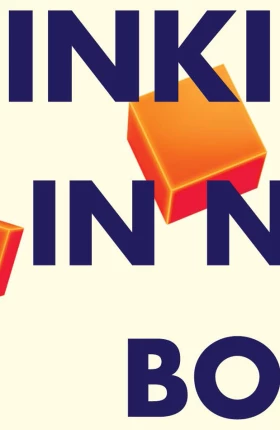Nearly all organizations and their leaders feel the imperative to grow and to innovate and thereby to generate value for shareholders and society. Responding to this imperative demands creativity and discipline in equal measure—and most executives would say that, of the two, creativity is the harder to come by.
BCG creativity experts Luc de Brabandere and Alan Iny, who have helped innumerable clients generate their next big breakthrough ideas, have detailed their approach in their new book, Thinking in New Boxes: A New Paradigm for Business Creativity. They recently shared their thoughts on how to drive practical creativity.
Why did you write this book? Is it timely?
Today’s accelerating pace of change makes creativity essential for success. But in all industries, the lifespan of good ideas, which are necessary for achieving and sustaining leadership, is getting shorter and shorter. So it is imperative to adopt a better, more systematic way of generating the new ideas—the products, services, business models, processes, and the like—that will guarantee future leadership.
The traditional approaches to creativity—brainstorming and thinking outside the box, for instance—are useful tools in and of themselves, but they have not been wielded effectively. Thinking in new boxes, an approach that emerged from our work with clients and our understanding of the mind, is a practical solution to the challenge of fostering creativity.
Can you give some examples of what effective creativity looks like in practice?
BIC provides an excellent real-life example. The company was founded as a pen manufacturer and was doing well as a pen manufacturer. You can imagine that if BIC employees at that time had been told to think outside the box, they might have proposed ideas like four-color pens, erasable pens, or pens customized with a customer’s logo. But if someone had suggested making lighters or razors, the reaction might have been, “What are you talking about—we’re a pen company!”
Indeed, if you are boxed in by the idea that “we’re a pen company,” then lighters and razors are bad ideas. But consider what happens if you shift your mental construct entirely and adopt a new outlook—something like, “we make disposable plastic items.” When you look at BIC’s business capabilities from that perspective, then lighters and razors become perfectly logical ideas, and you open the door to expanding profits and revenues.
Good examples of business creativity can be found in companies of all sizes. A Russian café chain called Tsiferblat, for example, has reinvented the entire coffee-shop business model. The cafés roast their own coffee, but it’s free. The Wi-Fi is also free—and so are the snacks. You pay only for your time. Lots of people look at coffee shops as places to sit and work or have a meeting, but the mental box of the people running most coffee chains is still, “we sell coffee.” Tsiferblat adopted a completely new mental box of, “we’re a comfortable meeting venue.” Within that new perspective, coffee, food, and Internet service become amenities, not products. The space is the product, and time is the commodity you pay for.
The history of business is teeming with examples of this kind of creativity, where someone or some company replaced an old mental box with a new one, thereby changing their company—and sometimes even their entire industry—as a result. Even a small change can have a big impact. Two employees in a sandwich shop, for example, replaced their standard tip jar with dueling receptacles, each bearing the name of a popular TV show, and asked customers to vote for their favorite show with their wallets. A new question to vote on appeared every day. The result? A 50 percent rise in tips—and a lot more fun for everyone.
Why isn’t thinking outside the box enough to help companies break free of old ideas that have them boxed in?
Thinking outside the box is impossible to do: even if we do manage to get out of any given box, we cannot help but climb into another one to make sense of the world around us. It’s also a buzzword that fails to embrace the most important first step to breakthrough creativity: identifying what your current boxes are and then doubting them. When people are pushed to think outside the box, rarely do they stop to ask, “Well, exactly what box am I in that I need to escape from?” And these invisible biases may be holding them back or pushing them in the wrong direction.
Our minds need all kinds of constructs to organize the world around us and to come up with practical ideas. That’s why we need to think in new boxes. They focus a team’s creativity and make it easier to build ideas. They also keep brainstorming sessions from generating hundreds of random notions. To be useful and practical, the creative process needs to address a specific question or problem that is well defined in advance—and it should respect specific criteria and constraints to ensure that solutions will be sufficiently practical to implement.
Brainstorming, in particular, can be frustrating for organizations. How can the process be improved by thinking in new boxes?
To people who think that brainstorming is painful and unproductive, we would say that it is like getting mad at the hammer when you hit your thumb. You need to learn how to use the tool properly rather than throw away the hammer. So for creativity, you need to use brainstorming sessions properly, identifying your current mental boxes and thoughtfully questioning and doubting them. Randomly trying to think up ideas that no one has ever had before is an unfocused, high-pressure activity that rarely leads to useful results—and it can feel threatening and risky for participants.
One note: It’s important to distinguish painful from unproductive. An effective brainstorming session is challenging because it takes you out of your comfort zone. If there is no discomfort at all, then it’s not a success: you are just boiling the same soup again and again.
We’ve talked a lot about business, but you see Thinking in New Boxes as being much broader. Can you explain?
Our message is that there’s room for improvement for everybody. The key is to become more aware of the way you think and more aware of the models you use to make sense of all aspects of your life. In business, thinking in new boxes can certainly help you develop new products, but it can also improve the way you approach any problem—from organizational design to cost-cutting. In your personal life, what are your assumptions about the right way to raise children? Or the right way to manage your career? Or the right way to plan for retirement—or run a family business or support your community? Becoming more aware of the assumptions and constraints that you’re operating under and then selectively challenging them can lead to greater creativity throughout your life.
There really isn’t any difference in how you apply creativity in your day-to-day life versus how you apply it at work. We can all get mentally stuck sometimes. But once you understand the role that mental boxes play in why we get stuck—and have a thoughtful approach to practical creativity—it will be much easier, hopefully, to get unstuck.





